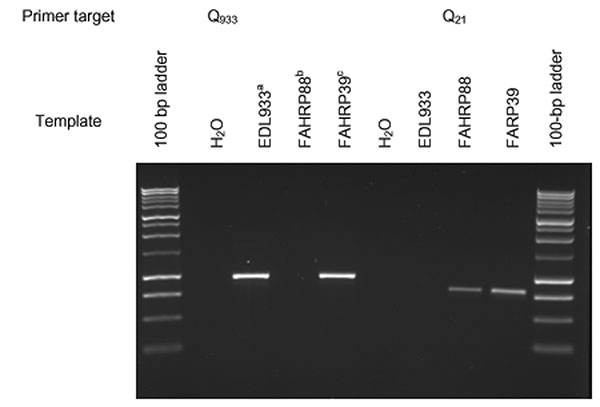Volume 10, Number 8—August 2004
Dispatch
Human Escherichia coli O157:H7 Genetic Marker in Isolates of Bovine Origin
Figure

Figure. Ethidium bromide–stained gel of the amplification products obtained from Q933-595 and Q21-595 polymerase chain reactions. aEDL933, human isolate (ATCC43895). Obtained from the STEC Center, Michigan State University. bFAHRP88, isolated from Ohio dairy cow. cFAHRP39, human isolate (E29962) (12).
References
- Karmali MA, Arbus GS, Petric M, Patrick ML, Roscoe M, Shaw J, Hospital-acquired Escherichia coli O157:H7 associated haemolytic uraemic syndrome in a nurse [letter]. Lancet. 1988;1:526. DOIPubMedGoogle Scholar
- O’Loughlin EV, Robins-Browne RM. Effect of Shiga toxin and Shiga-like toxins on eukaryotic cells. Microbes Infect. 2001;3:493–507. DOIPubMedGoogle Scholar
- Kimura N, Watanabe M, Komatsubara A. [Verotoxin producing ability of verotoxin-producing Escherichia coli strains isolated from fecal specimens of healthy persons is lower than that of patients]. Kansenshogaku Zasshi. 2000;74:849–51.PubMedGoogle Scholar
- Pradel N, Boukhors K, Bertin Y, Forestier C, Martin C, Livrelli V. Heterogeneity of Shiga toxin-producing Escherichia coli strains isolated from hemolytic-uremic syndrome patients, cattle, and food samples in central France. Appl Environ Microbiol. 2001;67:2460–8. DOIPubMedGoogle Scholar
- Wagner PL, Neely MN, Zhang X, Acheson DW, Waldor MK, Friedman DI. Role for a phage promoter in Shiga toxin 2 expression from a pathogenic Escherichia coli strain. J Bacteriol. 2001;183:2081–5. DOIPubMedGoogle Scholar
- Baker DR, Moxley RA, Francis DH. Variation in virulence in the gnotobiotic pig model of O157:H7 Escherichia coli strains of bovine and human origin. Adv Exp Med Biol. 1997;412:53–8.PubMedGoogle Scholar
- Kim J, Nietfeldt J, Benson AK. Octamer-based genome scanning distinguishes a unique subpopulation of Escherichia coli O157:H7 strains in cattle. Proc Natl Acad Sci U S A. 1999;96:13288–93. DOIPubMedGoogle Scholar
- McNally A, Roe AJ, Simpson S, Thomson-Carter FM, Hoey DE, Currie C, Differences in levels of secreted locus of enterocyte effacement proteins between human disease-associated and bovine Escherichia coli O157. Infect Immun. 2001;69:5107–14. DOIPubMedGoogle Scholar
- Unkmeir A, Schmidt H. Structural analysis of phage-borne stx genes and their flanking sequences in shiga toxin-producing Escherichia coli and Shigella dysenteriae type 1 strains. Infect Immun. 2000;68:4856–64. DOIPubMedGoogle Scholar
- Arber W, Enquist L, Hohn B, Murray K, Murray N. Experimental methods. In: Hendrix R, Roberts J, Stahl F, Weisberg R, editors. Lambda II. Cold Springs Harbor (NY): Cold Spring Harbor Laboratory; 1983.
- Schmidt H, Scheef J, Morabito S, Caprioli A, Wieler LH, Karch H. A new Shiga toxin 2 variant (Stx2f) from Escherichia coli isolated from pigeons. Appl Environ Microbiol. 2000;66:1205–8. DOIPubMedGoogle Scholar
- Dorn CR, Angrick E. Serotype O157:H7 Escherichia coli from bovine and meat sources. J Clin Microbiol. 1991;29:1225–31.PubMedGoogle Scholar
- Locking M. HUS rates in Scotland. Glasgow: Scottish Centre for Infection & Environmental Health; 2002.
- Elliott EJ, Robins-Browne RM, O’Loughlin EV, Bennett-Wood V, Bourke J, Henning P, Nationwide study of haemolytic uraemic syndrome: clinical, microbiological, and epidemiological features. Arch Dis Child. 2001;85:125–31. DOIPubMedGoogle Scholar
- Karch H, Russmann H, Schmidt H, Schwarzkopf A, Heesemann J. Long-term shedding and clonal turnover of enterohemorrhagic Escherichia coli O157 in diarrheal diseases. J Clin Microbiol. 1995;33:1602–5.PubMedGoogle Scholar
Page created: March 01, 2011
Page updated: March 01, 2011
Page reviewed: March 01, 2011
The conclusions, findings, and opinions expressed by authors contributing to this journal do not necessarily reflect the official position of the U.S. Department of Health and Human Services, the Public Health Service, the Centers for Disease Control and Prevention, or the authors' affiliated institutions. Use of trade names is for identification only and does not imply endorsement by any of the groups named above.